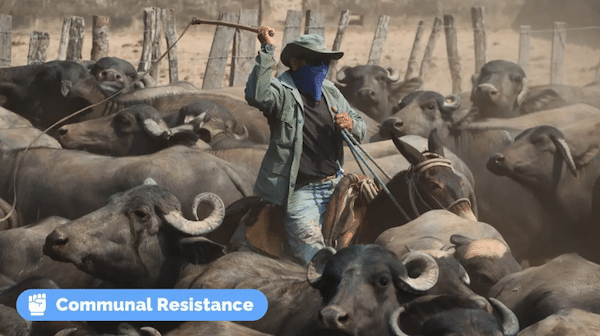The latest installment in the Communal Resistance Series takes us to the Pancha Vásquez commune in Apure State in the Venezuelan plains region [Llanos]. The Venezuelan Llanos are legendary for their rich cultural heritage and spectacular landscapes, but they are also rife with political and social contradictions. These include issues relating to land ownership, Indigenous rights and dispossession, and spillover from neighboring Colombia’s internal conflict.
Located on the outskirts of Elorza, in the southwest of the state, Pancha Vásquez is a huge commune in terms of territory. The commune comprises fourteen communal councils, three of which focus on agriculture, while eleven are dedicated to cattle rearing. The lands in this vast territory are mostly in the hands of small to mid-sized producers who take pride not only in their equestrian traditions and folklore but also in the special role that Elorza played in Hugo Chávez’s biography. That is because, as a young officer, Chávez was stationed in Elorza from 1985 to 1987 and sharpened his political vision there.
Part I of this three-part series dealt with the history and productive activities of the Pancha Vásquez Commune. Here in Part II we look at how the communards have resisted the devastating effects of the U.S. blockade. In the next delivery, we will learn about the years that a young army officer named Hugo Chávez spent in Elorza, the closest urban center to the Pancha Vásquez Commune.
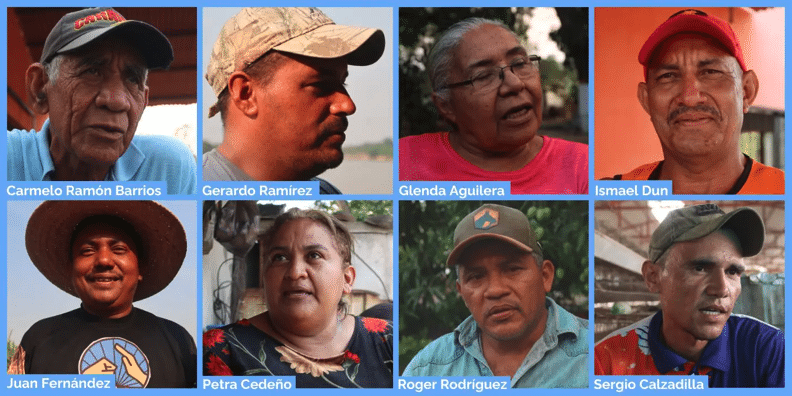
Carmelo Ramón Barrios is a Pancha Vásquez parliamentarian and small-scale rancher | Gerardo Ramírez spokesperson for the Pancha Vásquez Commune and cattle rancher | Glenda Aguilera is part of the Pancha Vásquez Commune and a producer of artisanal foods | Ismael Dun is a Pancha Vásquez parliamentarian and small-scale rancher | Juan Fernández is a communal parliamentarian and one of the founders of Pancha Vásquez Commune| Petra Cedeño is a parliamentarian at Pancha Vásquez Commune and cattle rancher | Róger Rodríguez is a cattle rancher in the Pancha Vásquez Commune | Sergio Calzadilla is a Pancha Vásquez parliamentarian and works at El Reencuentro Milk Collection Center (Photo: Rome Arrieche)
A Collection and Distribution Center
The Pancha Vazquez commune has recently inaugurated a Collection and Distribution Center as part of the government’s Communal Circuits initiative. The center consists of a 440 m² single-story building equipped with walk-in refrigerators. The project was funded by the government and built with volunteer labor.
ORIGINS OF THE PROJECT
Juan Fernández: In 2018, our commune began to directly exchange goods, via barter, with other communes, particularly with El Maizal. That was when the economic war against the Venezuelan people was at its peak.
Exchanging goods with El Maizal was a truly enriching experience: it brought the two communes closer and helped meet the community’s needs. Chávez emphasized that communes should build real ties with each other—ties outside the capitalist market.
We created a store called “Abasto Comunal Pancha Vásquez-El Maizal,” where people from both communes could purchase our respective goods at much lower prices. The inspiration came from Chávez’s ideas but also the situation we were going through.
At that time getting cornmeal was practically impossible here, but we obtained it from El Maizal. On the other hand meat was a luxury that few could afford in Simón Planas township [El Maizal], but we made the meat from Pancha Vazquez commune available to everyone.
Our storefront in Elorza remained open through 2020. Unfortunately, the COVID pandemic hit us hard. The pandemic, combined with fuel shortages, brought down the barter project. However, we learned many valuable lessons from the initiative
More recently, about two years ago, the Communal Economic Circuits were created by the Ministry of Communes. The Circuits are an initiative to promote communal production and distribution, so we proposed that Pancha Vásquez be incorporated as a meat and cheese producer. The Ministry eventually accepted our proposal.
Yet meat and cheese distribution requires refrigeration. That’s where the Pancha Vásquez Collection and Distribution Center comes in. On our commune’s ninth anniversary in 2023, we applied for funding for a collection and distribution center from the Ministry of Communes.
Petra Cedeño: We received USD $69,000 from SAFONAPP [an institution linked to the Ministry of Communes]. One year later, on our commune’s tenth anniversary, we were able to open the Center’s doors. It’s been a lot of hard work and sacrifice, but we are really happy!
The Center has two walk-in refrigerators that are already working. We can store 3,000 kilos of cheese and 8,000 kilos of meat there. This is crucial for the producers in our commune. In this hot climate, cheese and meat can turn bad very quickly.
Additionally, we are now building a store called “Communal Abasto” that is located in the Collection and Distribution Center. Local producers will be able to purchase agricultural inputs and other basic goods at lower prices in the store. There will also be an office, a meeting room, and accommodation for visitors.
There is no doubt that the institutional funding for this project was critical. However, the project was actually realized because some communards were completely committed to making it possible.
To build this large facility, we had to be very careful with every penny and seek solidarity from our fellow communards. For instance, many of the construction materials were sold to us at cost, and the plot of land where the Center was built was given over to us by Carmen Alguilar, Juan Fernández’s mom.
Building a commune always comes with some sacrifices… but also rewards!
OBJECTIVES
Róger Rodríguez: The U.S. blockade and economic war against our people have done real damage to our production. One major bottleneck is getting our products to market, because fuel is so scarce. Moreover, everyone knows that intermediaries are the bane of the people who work the land. They are the scrooges of today.
Now, with the Collection and Distribution Center in our commune, we can plan better and reduce our dependence on intermediaries. There is another issue that the Collection and Distribution Center will help to solve: during the rainy season, our cheese production goes up, but the price that intermediaries will pay per kilo drops dramatically. Sometimes the price goes so low that we struggle to make ends meet.
One of the benefits of the new center is that we can store cheese during the rainy season and wait for prices to rise during the dry season before selling it.
Finally, another benefit of the Collection and Distribution Center is that it will soon include an “Abasto Comunal” store where we will be able to purchase agricultural inputs at lower prices and, in some cases, exchange cheese or meat to get the inputs we need.
Juan Fernández: The key objective of the Collection and Distribution Center is to reduce our dependence on intermediaries. They come to our ranches and offer really low prices for our production, especially when fuel is scarce. Many of us are under enormous economic pressure, so we are forced to sell in unfavorable conditions.
This is not unique to our commune or even to our country; campesinos all around the world face similar exploitation from capitalists. However, in the context of a brutal blockade, small producers become even more vulnerable. That is why the new center is so important for our commune.
The storage facility will also help us build stronger links with other communes. During the rainy season, the price of cheese can drop below one dollar per kilo here, while it can rise up to four, five, or even six dollars in Caracas.
One of our plans to address this problem is to establish inter-communal exchanges with communes such as El Maizal, El Sur Existe, and El Panal. We would sell our cheese there at more affordable prices, while they could provide their own goods to our commune.
Building tangible links between communes is crucial. We participate in the Communard Union which is an extraordinary iniative bringing together some 30 communes. I think that the Union is one of places where Chávez’s legacy is most alive. Even so, if we cannot build links among the communes outside of the capitalist market, the Union won’t live up to its goals.
The most important thing about Pancha Vasquez’s new Collection and Distribution Center is that it is the commune’s first social property enterprise. The commune’s parliament, which includes spokespeople from all 14 communal councils, meets every two weeks to oversee its operation.
It is also important that the Center is becoming a meeting point for the communards here.
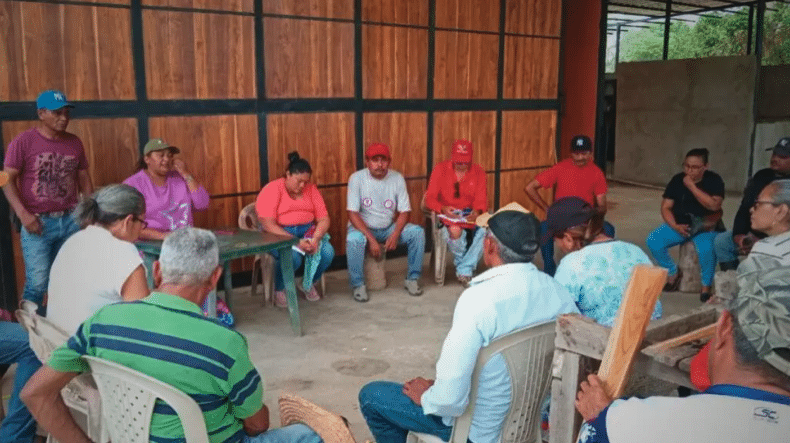
An assembly at the Collection and Distribution Center (Photo: Pancha Vásquez Commune)
The Impact of the U.S. Blockade
The impact of the sanctions has been particularly hard in this region bordering Colombia. Here, communards from the Pancha Vásquez reflect on the impact of the unilateral coercive measures.
THE ORIGINS
Juan Fernández: Joe Biden, Donald Trump, Barack Obama, and the interests that they represent imposed a blockade on our country because they wanted to punish Venezuela for attempting to build a new socialist model. They wanted to make an example of us.
However, the blockade has also happened because there is a band of traitors here in Venezuela who have no love for their country and are willing to sacrifice the Venezuelan pueblo. Fortunately, they have not succeeded, but the damage has been enormous.
This doesn’t mean that we do everything well here. Sometimes it feels like the blockade has also generated an internal blockade: some political actors here are not committed to the revolution. Addressing these issues remains a pending task.
CONSEQUENCES
Sergio Calzadilla: The blockade has had many interrelated effects. In terms of production, we face two main problems: fuel and inputs. My best estimate is that production dropped by about half in our commune. However, that didn’t happen in this municipality alone.
I’m an agronomist by training, and I have been researching cattle production in our state. Some years ago, there were 1,865,000 cattle heads in Apure. Today there are about 800,000 heads. Poor feed quality, limited access to supplements, and loss of qualified labor due to migration have caused the herds to decline. Also, maintaining the genetic profile of the animals requires careful rearing, which is difficult under current conditions.
Another factor is that water pumps are essential for watering our herds during the dry season. The blackouts, fuel shortages, and high maintenance costs have rendered many pumps inoperative.
When we look at agricultural production in our municipality, my estimate is that it went down by about 90%. Recently, agricultural output has been picking up slowly, but we are very far from our capacity.
The primary reason for this dramatic drop is the cost of inputs. Inputs are so expensive that most campesinos cannot afford them. Additionally, global warming is also affecting production. Rising temperatures and protracted dry seasons have had tangible effects.
FUEL SHORTAGES AND COMMUNAL SOLUTIONS
Juan Fernández: Most producers will tell you that access to fuel is our main problem. We began experiencing fuel shortages around 2017. The problem was exacerbated by local mafias who hoarded and then sold gasoline at two to three dollars per liter, while the official “international” (i.e. non-subsidized) price is 50 cents.
Gasoline distribution is more stable now, with supply rationed at 40 liters twice per week at the official international price. However, getting diesel fuel is still a major issue. PDVSA distributes diesel using a rationing system based on license plate numbers, but only larger producers have the permits [permiso de mina]. The subsidized price of diesel is 18 cents per liter, which means $36 for a 200 liter drum.
However, there are black market dealers who sell diesel at $1 per liter. Ranchers need significant amounts of diesel because the distances are long here. We can’t store milk, cheese, or meat at the ranch due to the lack of cooling systems, so we take our production either to the Collection Center or the market.
We also have to get supplies to the farms on a regular basis and maintain the fields with heavy machinery. All that takes diesel fuel. Finally, we often rely on generators for electricity and pumping water… which, once again, requires diesel.
Many city folk are unaware that agricultural production is so heavily fuel-dependent, especially in Apure, where the drive from a ranch to town can take up to two hours. Without fuel, food production collapses.
Fortunately, since President Maduro’s visit to Apure in early 2024, they’ve implemented a contingency plan. The president learned that many producers here had no access to diesel fuel and it was affecting production, so he set in motion the “Fuel Saturation Plan” [Plan Saturación de Combustible].
There’s been a small hike in production since then, so we celebrate the initiative. It’s not perfect, however, since fuel transportation is done by private companies, which puts the price at 30 cents per liter and not the established 18 cents.
The last time I bought diesel at the official price was in November 2023, paying $36 for a 200 liter drum. Now, it’s $60 for the same amount. This is tough on small to mid-sized producers, but the overall situation has improved.
The plan has the communal government distributing diesel. Since we took charge the distribution, we have been scaling up our radius of action. Right now we are reaching more than 50% of the producers in the territory. That’s a great success!
RANCHERS’ VOICES
Petra Cedeño: The impact of the blockade is multifaceted. Agricultural production has been most directly affected, dropping an estimated 90% due to the unavailability of diesel fuel. All this is compounded by the high prices of agricultural inputs.
As a cattle rancher, diesel shortages affect my production, but we also face other problems. We produce cheese on our farm, but there was a time when rennet was really hard to get, so our production went down.
Finally, there is the social dimension of the blockade. Because of the poverty and problems of services such as electricity, many people migrated. The phenomenon began in 2017. Most people are going to nearby Colombia, but over the past few months, a growing number are trying to make their way to the U.S. via the Darién. In the Rómulo Gallegos Municipality, at least 30 people leave monthly, sometimes up to 100.
This breaks my heart. I love this land, its culture, and its traditions, and it’s very sad to see so many people leaving… but the truth is that things aren’t easy, particularly for the youth.
This situation makes me resentful toward the U.S. Why are they so committed to hurting the working people of Venezuela? They say they want to promote “regime change,” but shouldn’t that be our decision?
Carmelo Ramón Barrios: Every last person has been affected by the crisis. Before the blockade, I used to produce 80 to 100 liters of milk daily. Now my production is down to 40 liters.
The blockade has also brought other problems. In Caracas you use the bolívar and the U.S. dollar. Here the main currency is the Colombian peso. We are just two hours away from the border, so when hyperinflation began to affect the bolivar, every store, every provider of agricultural inputs, and every fuel reseller began to sell in Colombian pesos.
Initially, this was very difficult for small producers. Now we’ve adapted to this “new normal,” but it’s not ideal. Venezuela should have its own robust and reliable currency!
Gerardo Ramírez: Overall, I would say that the blockade has set us back some 50 years. Is that an exaggeration? No! We went back to using donkeys because fuel is hard to get; we have two to four-hour blackouts every day; and our farm equipment is out of order, because we can’t afford to maintain it.
I used to have three working tractors and now I only have one. And I am one of the lucky ones! Many producers have given up on maintaining their farm equipment because it’s simply too expensive to do so.
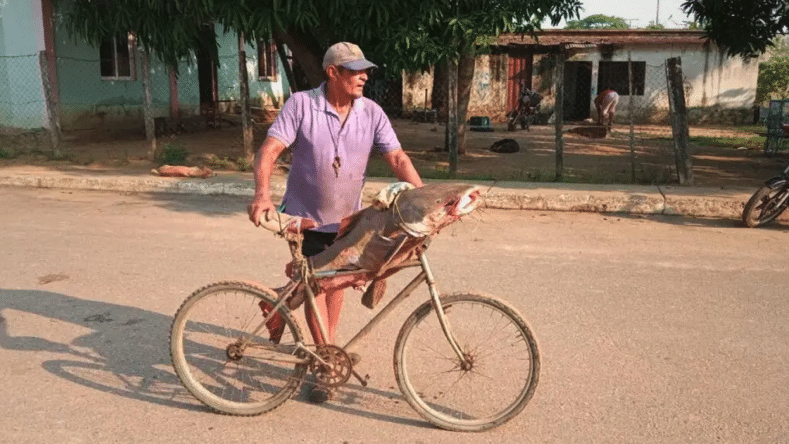
In addition to raising cattle and farming, communards also fish in the Elorza River. (Photo: Juan Fernández)
Creative Solutions
Pancha Vásquez communards have found innovative ways to survive and produce under the blockade.
Ismael Dun: The commune has been the key to our survival. I’ll give you three examples. First, before the pandemic, the exchange between El Maizal and Pancha Vásquez communes ensured our access to cornmeal and other basic goods, while we in turn provided meat and cheese to our brothers and sisters in Lara state [referring to El Maizal communards]. The exchange was a self-run initiative that solved a real problem, while helping build stronger ties between the communes.
Additionally, since early 2024, the Pancha Vásquez Commune has been a hub for diesel distribution. Finally, as we look into the future, our new Collection and Distribution Center is sure to become an asset for local producers: it will generate better conditions for the sale of our cheese and meat, and we will soon be able to purchase agricultural inputs at lower prices there. We will be greatly relieved when we are able to bypass the commercial agro-input retailers.
I think the commune is the solution to our problems. Comandante Chávez died saying “Commune or nothing!” He was right.
Roger Rodríguez: I am at a loss for words to describe the impact of the blockade. In my family farm, we dropped from 350 heads of cattle to 40. However, we fought back. We are now making our own animal feed, and we are breeding goats and sheep instead of cattle.
In all this, the commune has been of great help. If we run out of gas, gasoline, or diesel, there’s always a helping hand. I am a Christian: I value collaboration and solidarity… and that’s what the commune promotes!
Sergio Calzadilla: In Apure in general, but specifically in the Pancha Vasquez Commune, we are experiencing two important shifts in terms of production. First, agriculture is being displaced, mostly because of the high costs of inputs. It used to be that many ranchers would grow corn and other crops as supplementary food for the cattle. Not anymore.
Second, many ranchers are shifting from cows to buffalo. Buffalos are more robust and their milk is richer: you need 7 liters of cow milk per kilo of cheese, but just 4.5 liters of buffalo milk per kilo, because it has more fat and is richer in lactose.
Glenda Aguilera: About two years ago I began to make artisanal products such as jams, milk cream, milk candy [dulce de leche], hot sauces, and so on, to sell in the communal market. This has become an important way to supplement our household income in these times of crisis.
I also keep a medicinal herb garden and I make coconut oil and noni tincture. Noni cures many maladies, from bunions to certain cancers. When it’s hard to get medicines, these alternatives are all the more important.
Sergio Calzadilla: The blockade teaches us that we have to overcome import dependency. That’s why I’m promoting a transition away from conventional agricultural inputs in the commune. Also, I am giving workshops on how to make organic fertilizer. I’m happy to say that some campesinos here are implementing these practices in their conucos [subsistence plots], but we have to go beyond that. The transition must be as ideological as it is technical.
One of my objectives is to promote the construction of a plant to transform manure into organic fertilizer on a large scale. All animal feces can be turned into bio-gas and into solid or liquid organic fertilizers.
I know that an initiative like this one would work: it would be economically viable and help overcome dependence on imported inputs.
Petra Cedeño: The Pancha Vásquez Commune has been a lifeline in the hardest times. It was the commune that guaranteed our access to cornmeal. It’s been the space where we meet to solve our problems. And it is now the place that ensures a fair distribution of diesel fuel, which is critical for production.
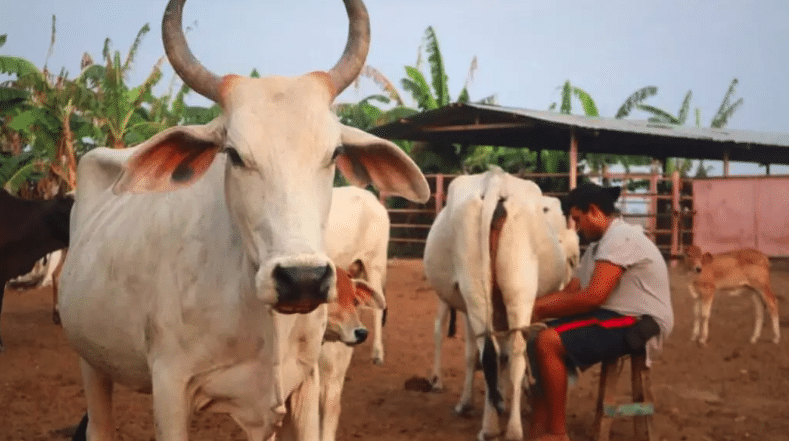
Milking cows in the early morning (Photo: Pancha Vásquez commune)
Read Part(s) 1 Here

